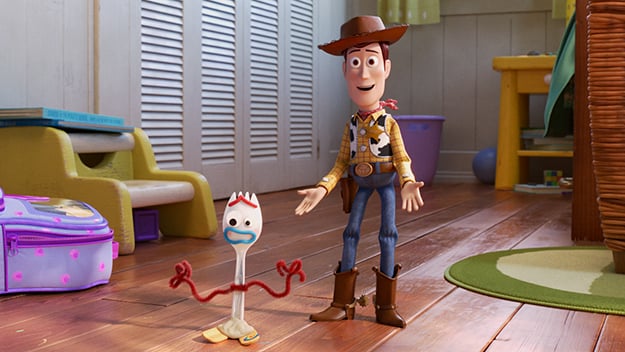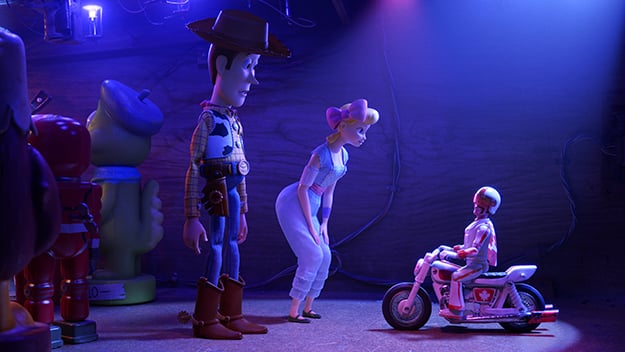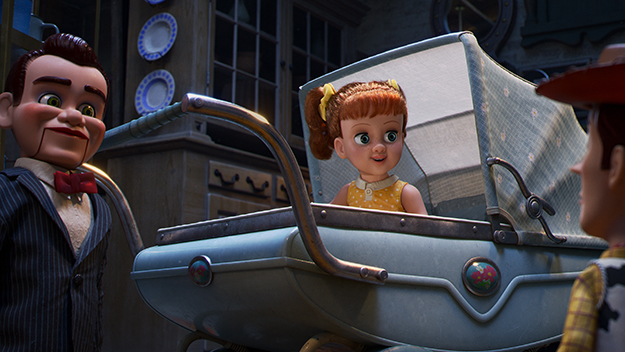Deep Focus: Toy Story 4

Images from Toy Story 4 (Josh Cooley, 2019)
The Toy Story movies have always said a lot about what it means to be a boy or girl, and what it means to be a toy. Pixar’s storytellers proved how much they thought about the most peripheral character—the toys’ original owner, Andy (John Morris)—in the improbably moving climax of Toy Story 3, when Andy, on his way to college, bequeathed Sheriff Woody (Tom Hanks), Space Ranger Buzz Lightyear (Tim Allen), cowgirl Jessie (Joan Cusack), dinosaur Rex (Wallace Shawn), and all the rest to a shy four-year-old neighbor, Bonnie, whom he was sure would take good care of them. As Andy paused to draw Bonnie into his erstwhile play world, we saw these cloth, plush, and plastic figures spark a broad and vivid imagination as well as decency and empathy. Andy’s attentiveness to each character made us understand why they were his toys. I was never much of a toy kid myself, apart from an obsessive attachment to a stuffed monkey named Jocko, but even to me their parting was sweet sorrow.
After tracing a complete arc from Toy Story to Toy Story 3, why would Pixar return for a fourth? Director Josh Cooley (a series neophyte) and executive producer Andrew Stanton (who helped write the first two Toy Storys, directed Finding Dory, and co-wrote and directed WALL·E), build the explanation into Woody’s latest quest. In the screenplay by Stanton and Stephany Folsomy (they and a slew of others share story credit), Woody, like these filmmakers, can’t give up doing something he loves, no matter how flimsy the justification. He keeps behaving like the righteous lawman uniting a toy chest’s diverse population in unwavering support of a child, Bonnie (Madeleine McGraw)—though Bonnie’s assertive rag doll Dolly (Bonnie Hunt), who predates Andy’s toys, challenges Woody’s leadership. And Bonnie hasn’t chosen to play with him for days. Out of all Andy’s hand-me-downs, she appears to prefer Jessie.
The filmmakers’ love and cleverness battle each other to a standstill in the narrative—the plot repeatedly doubles back on itself. But the combination pays off with virtuoso cadenzas centered on a reconfigured Bo Peep (Annie Potts), absent after Toy Story 2 (her shepherd’s crook here becomes a martial-arts staff) as well as the delightful new characters: Forky (Tony Hale), a refugee from a place setting at a school lunch, and Duke Caboom (Keanu Reeves), a lovably braggadocious Canadian stuntman action figure. Hanks, who should have won awards for his roles in Saving Mr. Banks, Captain Phillips, and The Post, has never been better as Woody. When Potts’s super-confident Bo Peep, Woody’s romantic ideal, asks why he must replay the same old toy-meets-child scenarios, Hanks makes us feel Woody’s confusion as he leaves her questions hanging in the air.

At the end of Toy Story 3, Andy tells Bonnie that Woody is special because he’ll never give up on her—and that’s true. He’s the one who understands how much kindergarten terrifies Bonnie. He stows away in her backpack on “orientation day,” then rescues her art supplies from the trash, along with a random spork (a spoon-like scoop topped with four tines), after a feckless boy dumps them there. Bonnie attaches googly eyes, ice-cream-stick feet, and red pipe-cleaner arms to the spork and names it “Forky.”
Toy Story fans accept that their manufactured heroes walk and move through a secret life consistent with their characters, then fall into “toy mode” whenever humans are around. Apparently, the spork becomes a toy when Bonnie sticks a Play-Doh monobrow and mouth on him and imbues him with an odd, inchoate personality. What makes Forky hilarious is that he insists he’s still trash. That’s all he says for minutes at a time. It’s like a riff on the tree-like humanoid saying “I am Groot” in the Guardian of the Galaxy movies, except “I am Groot” means many things, according to Groot’s inflections, and Forky just means that he is trash. (To him, being so feels cozy and secure.) He becomes an ideal comic foil for Woody, whom Hanks supplies with a bit of Jimmy Stewart’s stop-and-go loquaciousness, whether he’s trying to convince the plastic utensil to bond with a flesh-and-blood child, or restraining him from leaping into whatever waste container is at hand. Forky brings out the absurdist charm in everybody. Shawn’s anxiety-prone Rex, with his tiny Tyrannosaurus hands, marvels at the length of Forky’s pipe-cleaner arms. The visual humor reaches an ineffable peak with a shot of Forky sleeping blissfully in a trash basket, using a tissue as a blanket.
Woody’s quest seems clear: he must save Forky from self-destruction, persuade him to embrace toyhood, and reunite him with Bonnie after he jumps from her family’s RV during a road trip. The wit of the Pixar crew never lets up. It’s fun to take a toy’s-eye view of a vacation spot like “Grand Basin, est. 1855,” complete with a traveling carnival and a shop called Second Chance Antiques, est. 1986. The film takes a major detour when Woody sees Bo Peep’s signature night-table lamp in the antique store window, without Bo Peep or her three sheep, Billy, Goat, and Gruff. Venturing inside brings him and Forky face to big face with Gabby Gabby (Christina Hendricks), a big-faced pig-tailed doll, and her ominous coterie, the Dummies (Steve Purcell), dapper versions of sadistic ventriloquist puppets from Hugo in Dead of Night to Willy in “The Dummy” on The Twilight Zone to Fats in Magic. They kidnap Forky and hold him hostage (Gabby craves Woody’s pull-string voice box). When Woody re-connects with Bo Peep at her carnival hideout, they lay plans to free Forky and bring him back alive to Bonnie, with the help of Buzz and Duke Caboom and the gang in the RV.

The film works out each individual’s destiny with humor and clarity, and the performances are spot-on. It’s refreshing for Potts and the animators to turn Bo Peep into a kick-ass Clara Barton for toys dumped in sandlots and playgrounds, with Billy, Goat, and Gruff driving a skunk-mobile packed with repair items. (Why the skunk shape? It scares off shrieking human crowds.)
The storylines, though, get tangled and repetitive as Woody questions the others’ loyalty to Forky, and they doubt Woody’s loyalty to them. Everyone is always running in place or going back somewhere, whether to the antique shop or the carousel. The filmmakers must be trying to link this pattern to Woody’s realization that he’s running in place. But the only solution to Woody’s problem is his ceasing to be a toy at all—instead becoming the consort of the superheroine Bo Peep, who aims to crisscross the country, saving other toys along the way. The movie says that Woody must grow out of his dependency on a child—be it Andy or a Bonnie—though a toy is defined by having a child play with it.
This dead-end quality blunted my enthusiasm. So did the filmmakers’ blithe breaking of its own cardinal rule: toys should not address people. When Woody threatened Sid death in Toy Story, it was designed to be a turning-point in that particular story. Here it’s a plot device to get the family RV back to the carnival.
Toy Story 4 lacks the unstressed symbiosis between child and plaything that opened up the series to a wide variety of humor and surprising emotional connections. Still, it’s replete with invention and good feeling. Jordan Peele and Keegan-Michael Key are beautifully cast as “Bunny” and “Ducky,” two rumbustious cheap plush animals enraged by years spent unclaimed at a carnival game. And in the funniest running joke, Buzz fixates on the concept of “an inner voice.” He keeps punching his spacesuit’s voice buttons and analyzing the pre-recorded messages as statements from his conscience. At one point he thinks it’s telling him, with the weight of a moral conviction, “The slingshot maneuver is all we’ve got!”
Toy Story 4 is a must-see for its beauty, drollery, and charm. But when it comes to the story, the boomerang maneuver is all it’s got.
Michael Sragow is a contributing editor to Film Comment and writes its Deep Focus column. He is a member of the National Society of Film Critics and the Los Angeles Film Critics Association.







